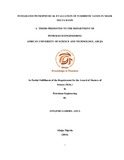| dc.description.abstract | Large quantities of petroleum resources in the Niger Delta province are confined to unconsolidated turbiditic and silici-clastic rocks. These rocks are usually associated with high volumes of shale. The high volumes of shale create discontinuities within the reservoir units causing division of the reservoir into several flow units. The complex nature of these reservoir units coupled with the incidence of many thin beds within them makes it difficult to conduct credible petrophysical evaluation using conventional log and core data. These types of data are however the most common data available for most wells in the Niger Delta region.
In this research, an integrated approach is adopted in petrophysical evaluation of the reservoir sands using conventional log and core data. The stock tank oil originally in place is estimated using three different methods. These include;
I. Deterministic approach without consideration to the internal divisions (flow units) within
the reservoir.
II. Deterministic approach with consideration to internal divisions (flow units) within the reservoir and
III. Probabilistic approach with sensitivity analysis for three different cases of net pay thickness.
The outcome of the research showed that, when a deterministic evaluation is done without considering internal divisions, the value for STOOIP is greater than that which considers internal divisions of the reservoir. The range of STOOIP’s observed for the probabilistic approach is relatively wide and therefore lends credence to the unpredictable nature of turbiditic sands. Many internal divisions within a relatively thin thickness of sand also highlights the internal discontinuities within the reservoir units. The research also highlighted that, sensitivity of STOOIP to particular input parameters is reservoir dependent.
In conclusion, the integrated approach for petrophysical evaluation of turbiditic formations enables better and thorough understanding of the reservoir units. Decisions can therefore be based on the outcomes from this method going forward. | en_US |

